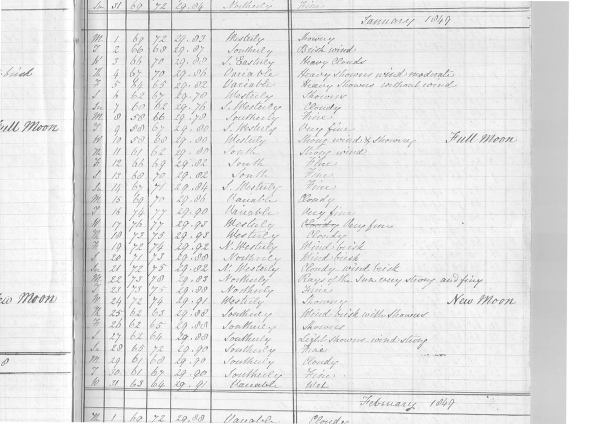The discovery of diaries of an English missionary living in Northland in the 1800s reveals him as New Zealand’s first meteorologist.
It took Drew Lorrey only a matter of seconds to realise what he’d found.
The NIWA climate scientist was searching the National Register of Archives when the name Richard Davis appeared, with reference to his diaries and two volumes of meticulous meteorological records. These diaries, in fine, looping handwriting, were, Dr Lorrey says, “hiding in plain sight”.
Lorrey believes they could be the earliest continuous land-based meteorological measurements made in New Zealand. Regular land-based meteorological observations in New Zealand had been started in the early to mid 1850s by the Royal Engineers in Auckland.
“We’ve given Richard Davis the title of New Zealand’s first meteorologist because of the length and detail of the data he kept – the earliest reported quantitative meteorological account for New Zealand kept over multiple years,” says Dr Lorrey.
Dr Lorrey and colleague Petra Pearce are part of an international scientific collaboration that digitises historical weather observations.
Who is Reverend Davis?
Richard Davis’s inadvertent contribution to this project started more than 175 years ago. He was an English colonial-era missionary, sent from Dorset to Northland by the Church Mission Society, arriving in 1824 aged 34, with his wife Mary and their six children.
A farmer by profession, he established a farm at Waimate North. It was arduous work; suitable land was scarce, and crops failed. Rev. Davis was a prolific correspondent, sending thousands of letters back to friends in England.
In his letters he details the busy comings and goings around the Bay of Islands, his interactions with local Māori and his efforts to grow plants, including fruit trees and vegetables, from seeds sent from England. A vital part of this endeavour required an understanding of the local climate.
Rev. Davis recorded the temperature each day at 9am and again at midday, along with a midday pressure measurement. He also commented on wind flow, wind strength and cloud cover, and made notes about extreme weather events.
The records that survive cover nine years of weather observations in two parts, from 1839 to 1844 and from 1848 to 1851. The intervening gap corresponds to the time he was ordained as a deacon and left Waimate to establish the Kaikohe Mission Station.
Accounts of snow in Auckland and Northland!
Two astounding entries record snow – adding to a total of six historic accounts of snow falling in Auckland and Northland, the latest in 2011.
On 30 July 1849, Rev. Davis wrote: “Hail storms. This morning the southern hills and Poutahi covered with snow.” And the next day: “This morning the hills were again covered with snow.”
The diaries reveal that, on average, winters were colder and summers warmer during Rev. Davis’s time, which may be a result of the poor placement of his thermometer.
Dr Lorrey and Mrs Pearce have now had a paper published on the diaries in the international scientific journal Climate of the Past. The Davis diaries will be fed into the 20th Century Reanalysis Project which aims to reconstruct six-hourly snapshots of the weather conditions across the globe.
Rev. Davis died in 1863 and is buried in the cemetery of the Waimate Mission House.


